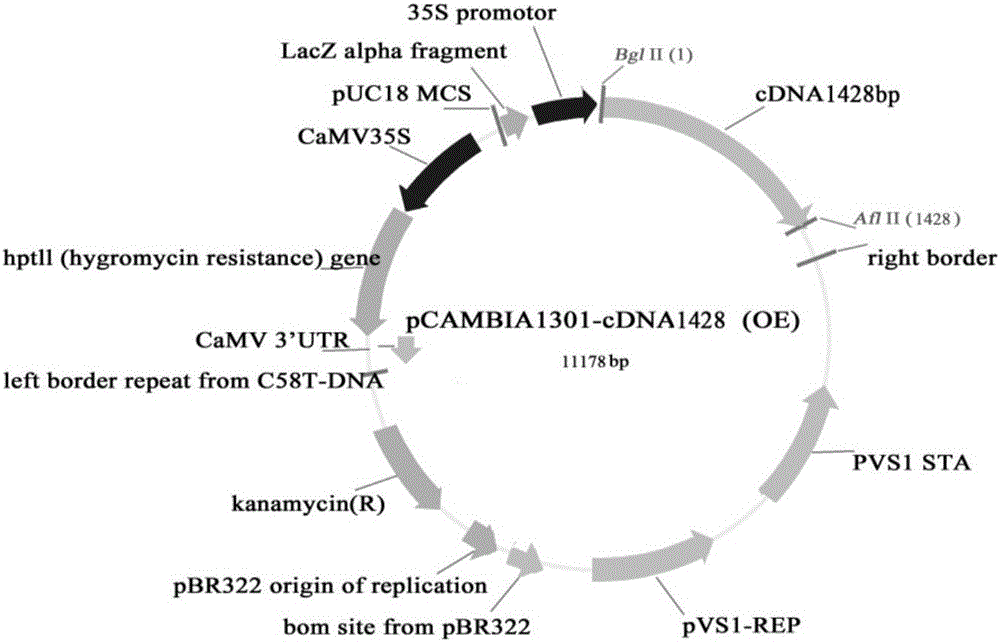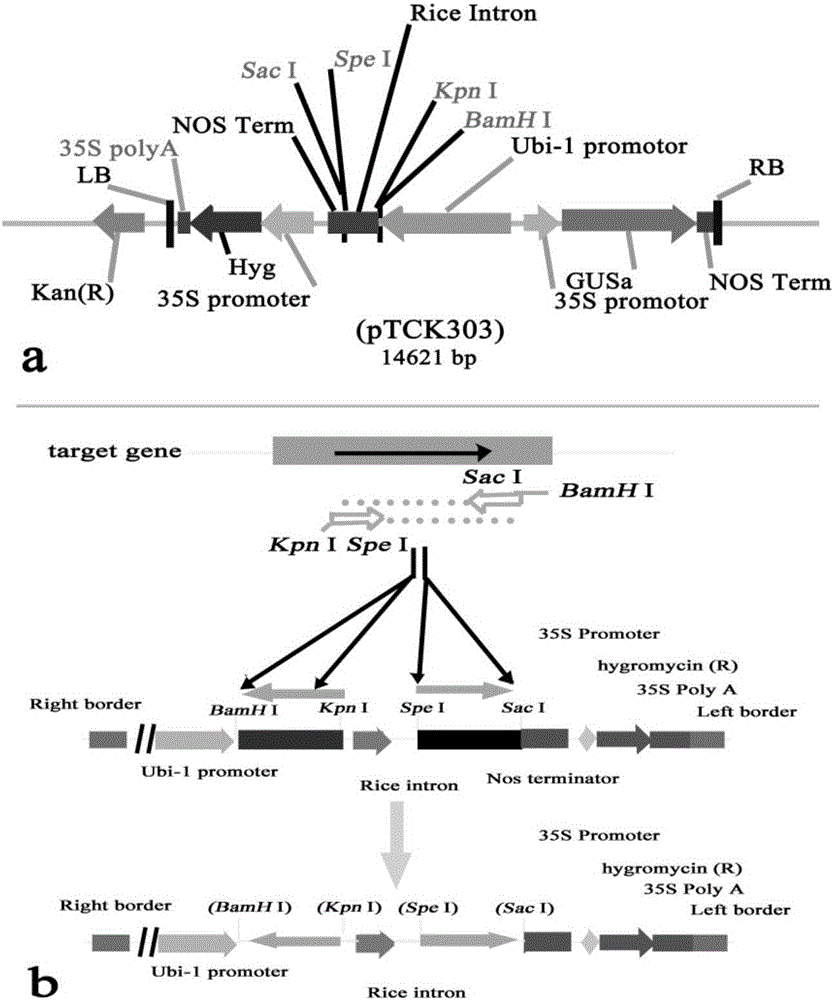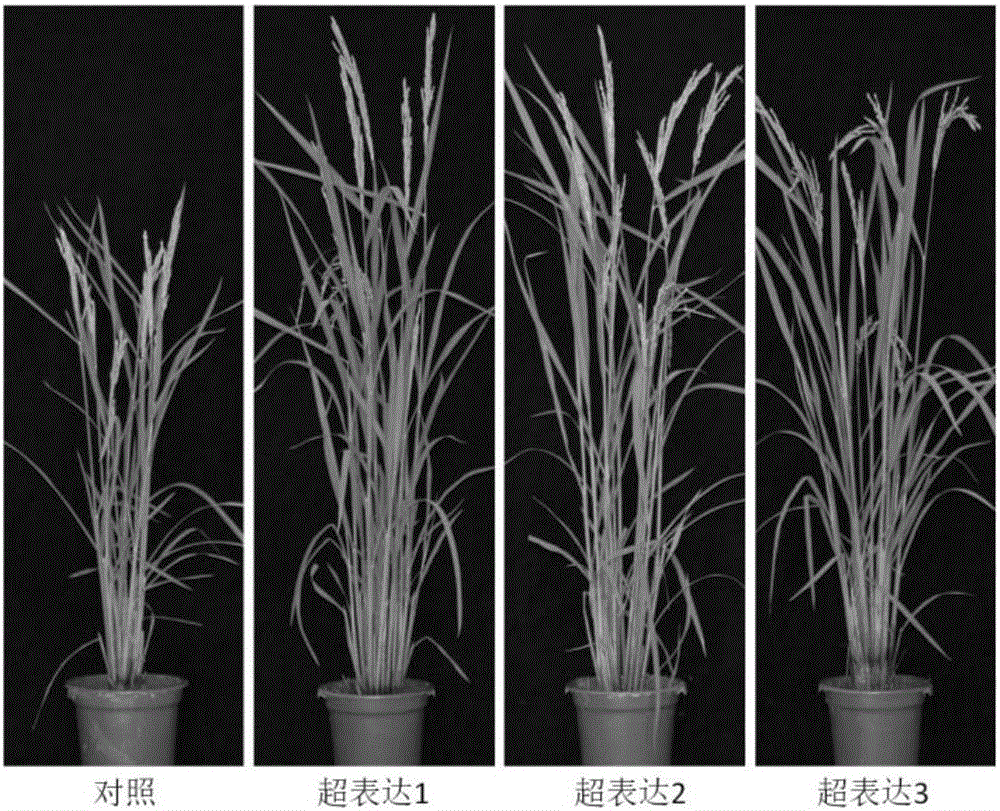Gene OsPTR10 for improving nitrogen utilization efficiency and yield of rice and applications of gene OsPTR10
A rice and gene technology, applied in the direction of genetic engineering, plant genetic improvement, application, etc., to achieve the effect of improving nitrogen absorption efficiency, increasing plant yield, and increasing yield
- Summary
- Abstract
- Description
- Claims
- Application Information
AI Technical Summary
Problems solved by technology
Method used
Image
Examples
Embodiment 1
[0038] [Example 1] Construction of Overexpression OsPTR10 Gene Plants
[0039] The RNA of rice Zhonghua 11 was extracted and reverse transcribed into cDNA, using
[0040] Primer F: ATGCCATATAAGTATGTACTA (Seq ID No: 3)
[0041] Primer R: TCAGTGCGAGTGCGGGACGGC (Seq ID No: 4)
[0042] After the cDNA of the OsPTR10 gene was amplified by PCR, it was connected into the pCAM1301 vector, and the pCAM1301 vector was constructed from Cambia Company to construct the overexpression vector OsPTR10-p1301 of the OsPTR10 gene, such as figure 1 shown. Using the genetic transformation method mediated by Agrobacterium EHA105, the overexpression vector was introduced into the normal rice variety Zhonghua 11.
[0043] After all the transgenic seedlings were obtained, they were transplanted into the frame with soil, watered and fertilized regularly, and when the seedlings grew about 10cm in height, they were planted in the field. The FP10 primer pair for detection is
[0044] F: GATGTTGGCGACC...
Embodiment 2
[0047] [Example 2] Construction of OsPTR10 gene interference plants and acquisition of OsPTR10 gene mutants
[0048] The cDNA of rice Zhonghua 11 was used with a primer pair:
[0049] F1: 5'ACTAGTCATCCCATCACTACAACC 3' (Seq ID No: 7)
[0050] R1: 5'GAGCTCGTATCCAAACGACGACAG 3' (Seq ID No:8)
[0051] F2: 5'GGTACCCATCCATCACTACAACC 3' (Seq ID No:9)
[0052] R2: 5'GGATCCGTATCCAAACGACGACAG 3' (Seq ID No: 10)
[0053] After the cDNA fragments of OsPTR10 gene were amplified by PCR, they were connected into the pTCK303 vector, which was donated by Zhongkang Laboratory, Institute of Botany, Chinese Academy of Sciences, and the interference vector OsPTR10-pTCK303 of OsPTR10 gene was constructed. Using the genetic transformation method mediated by Agrobacterium EHA105, the interference expression vector was introduced into the normal japonica rice variety Zhonghua 11, such as figure 2 shown.
[0054] Using the genetic transformation method mediated by Agrobacterium EHA105, the overex...
Embodiment 3
[0060] [Example 3] Identification of nitrogen use efficiency and yield indicators of transgenic plants and mutant plants
[0061] The number of tillers of the above-mentioned transgenic plants was counted, and it can be found that the three lines of the overexpressed plants of the OsPTR10 gene have more tillers than the control, while the three lines of the interference plants and the mutant plants have fewer tillers than the control, such as Figure 5 shown. Data were analyzed by SPSS software for analysis of variables (ANOVA), and Duncan's was used for significant difference analysis at the 0.05 level. Different groups of lowercase letters (such as a, b, c) indicate significant differences.
[0062] The leaves of the above plants were collected and the soluble protein content in the leaves was measured. It can be found that the soluble protein content of the leaves of the three strains of the overexpression plants was significantly higher than that of the control, while the...
PUM
 Login to View More
Login to View More Abstract
Description
Claims
Application Information
 Login to View More
Login to View More - R&D
- Intellectual Property
- Life Sciences
- Materials
- Tech Scout
- Unparalleled Data Quality
- Higher Quality Content
- 60% Fewer Hallucinations
Browse by: Latest US Patents, China's latest patents, Technical Efficacy Thesaurus, Application Domain, Technology Topic, Popular Technical Reports.
© 2025 PatSnap. All rights reserved.Legal|Privacy policy|Modern Slavery Act Transparency Statement|Sitemap|About US| Contact US: help@patsnap.com



